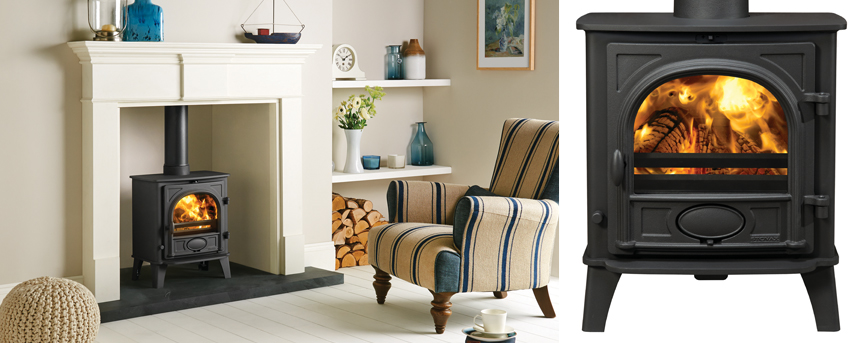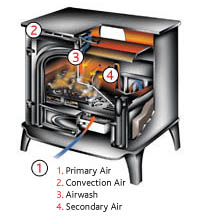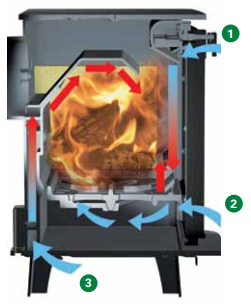
A wood burning stove is a sound investment for your home; if used to replace an older style open fire it has the potential to reduce your house’s carbon footprint by at least 14% and will really make the most of wood’s environmentally neutral and renewable energy. Making the decision to replace an existing inefficient appliance or to install a stove from scratch into your living space can feel daunting but there are plenty of options to choose from. This page will provide you with an explanation of the features you may wish to consider when choosing the right wood burning stove for your home.
Today, wood burning stoves are available in many different shapes, styles and sizes. The exact format for each Stovax stove is given on individual product pages but, in most cases, some or all of the following features will be included: an Airwash system for the window; a Cleanburn system with secondary air; an External air facility and an integral boiler to provide domestic hot water and run radiators.

Stockton 5 wood burning stove
Below are concise key points to consider before selecting the right stove for your home:
• Style/aesthetics you desire
• Heat output appropriate for the room/space you want to heat
• Fuel type – wood burning only or multi-fuel
• Do you wish the stove to heat water as well as the room?
• Are Cleanburn, Airwash and efficiency important to you?
• Is my stove Ecodesign Ready?
• Do you wish to burn wood in a Smoke Control Area?
All these aspects should be carefully considered before you make your investment but a Stovax retailer will be able to lead you through the options to ensure you choose a stove that will not only be a welcoming and warming feature in your home but a real asset to your heating system. Stovax has a nationwide network of dealers, many with stoves burning live in their showrooms so you can get a real impression of the final effect. A Stovax retailer will also be able to recommend trusted local installers for a professional fit so you can relax and enjoy the many benefits of owning a wood burning stove.
Wood burns best on a bed of ash with its combustion air coming from above, so wood burning only versions of stoves have a flat fuel bed and no ashpan.
Multi-fuel stoves usually have a riddling grate for the effective combustion of solid mineral fuels but also have Airwash so they can effectively burn wood as well. The riddling grate allows the ash and cinders from smokeless fuels, anthracite or peat/turf briquettes to be riddled into an ashpan, maintaining the primary airflow through the fuel bed and, hence, creating the optimum conditions for efficient combustion of those particular fuels.
According to the model, a Stovax multi-fuel stove may have either an internal or externally controlled system for riddling the grate.
Further information on the difference between wood burning stoves and multi-fuel stoves.

This is the air that is drawn into the wood burning stove, typically at a low level to maintain the combustion of the solid fuel being burnt. Usually, the primary air enters through a control on the front of the stove. The control can be adjusted to regulate the amount of air entering the firebox, thus giving you the opportunity to determine the intensity of the fire. This, in turn, will alter the heat output.
Primary air is the best way of controlling a stove burning solid mineral fuels and may also be used to start a wood fire. However, primary air is not normally used in a log fire once the logs are burning well.
Airwash is a specific design feature that uses a specially placed vent or vents to draw in cool air from the room; the air is then heated and ducted to ‘wash’ over the inside of the glass. This feature helps to keep the glass clean for longer, allowing you to enjoy the glow and flames to the full.
Airwash air is the best way of controlling a stove burning wood and can be used a small amount in a stove burning solid mineral fuels to keep the glass clean.
Where a Stovax wood burning stove includes a convection system, cool air from within the room is drawn into the convection chamber and then heated as it rises within the stove before flowing out into the room. The hot air rising draws more cool air into the stove, setting up a continuous flow and maintaining added heating efficiency.
Some Stovax stoves also have the option of an electrically operated fan to boost the convection process and provide a quicker warm-up time within your room.
Most Stovax wood burning stoves incorporate triple air systems to provide a cleaner burn, greater thermal efficiency and control of the flame picture as follows:

Introducing pre-heated, secondary air into the firebox at just the right point promotes efficient combustion of any unburnt hydrocarbons that may be in the smoke. This ‘cleanburn’ process can greatly increase the combustion efficiency of your wood burning stove and dramatically reduce the amount of unburnt particles going up the chimney. This can in turn reduce your servicing costs and save you money in fuel. It also gives you an improved flame visual.
All wood burning stoves with a heat output above 5kW require an additional flow of air for combustion into the rooms in which they are installed. An External Air facility allows this air to come directly from outside your building rather than through a vent into the room, thus eliminating draughts and adding to the overall heating efficiency.
Stovax High Output Boiler stoves are specifically designed to provide domestic hot water and/or run radiators as part of a stand-alone system. The number and size of radiators you can operate will depend on the ‘heat output to water’ of the particular model.
Alternatively, you can ‘link up’ some boiler stoves with your existing heating system. The ‘link up’ system can connect with gas or oil sealed heating systems, combi boilers, underfloor heating, advanced electronic controls and solar panels. This will help you to save money on fossil fuels and reduce your reliance on single-source heating.
In both cases, it is strongly recommended that you explain your requirements to an experienced stove retailer and/or heating engineer.
Most town and city homes are located in Smoke Control Areas as designated by the Clean Air Act 1993. To burn logs in a stove in these locations, the wood burning stove must be suitable for use in Smoke Control Areas.
This exemption is given only to appliances that have been independently tested to demonstrate particularly cleanburning combustion. Without this exemption, you may only burn smokeless fuels in a multi-fuel stove within a Smoke Control Area. Stovax has one of the most comprehensive choices of stoves for use in Smoke Control Areas.
More information on wood burning stoves in Smoke Control Areas.
Heralding a new era of ultra-green technology, Stovax Ecodesign wood burning and multi-fuel stoves and fires feature advanced combustion systems that burn so cleanly they are compliant with future 2022 flue gas emission and thermal efficiency standards.
Designed to meet or exceed Ecodesign standards, Stovax’s compliant stoves and fires ensure substances present in smoke emissions such as Carbon Monoxide (CO), nitrous oxides (NOX), organic gaseous compounds (OGC) and particulates (PM) are minimised – making them some of the most eco-friendly stoves in the world.
The future of solid-fuel heating, Ecodesign stoves and fires offer an even greener heating choice than standard appliances, without sacrificing flame visuals or heat output.
Sign up to our newsletter and receive the latest news and updates, including product launches, offers and promotions, exclusive giveaways and competitions, as well as seasonal tips and advice.
Subscribe Now!